 Janus Numbers
Janus Numbers
On other pages, you learned how to write numbers using the Musa digits. But aside from some minor differences, these symbols just replace the current symbols like 4 and +, with no change in the "spelling" of numbers or the "grammar" of expressions. And we don't need any more than that to begin using the Musa script for our familiar decimal numbers.

But Janus Numbers and the associated units of measurement (presented on the pages that follow) are interesting advances in their own right which the Musa script makes feasible - for instance, with the needed digits. For some of you, they may seem one step too far; for others, an additional reason to change scripts. Those in the first group need not continue - you've already seen everything you need to start using Musa.
Just as Musa letters can be used to write different languages, Musa numerals can also be used to write different "numeric languages". We are so accustomed to our own way of writing numbers, and it is so widespread, that we forget that it isn't the only one. For example, Roman numerals like XIV for 14 represent a different way of writing numbers.
This page will introduce another numeric language, called Janus notation in reference to the Roman god who faces both ways. This notation was developed by J. Halcro Johnston in his 1937 book, The Reverse Notation, on which this page is based. Numbers written in Janus notation are called Janus numbers.
Dozenal Numbers
You all know that our decimal numbers are base ten (decimal), presumably because we have ten fingers. What that means is that when we write a number by putting two digits next to each other, the lefthand digit doesn't represent units, it represents tens of units. For example, in the number 24, the digit 2 doesn't represent the number 2; it represents the number 20 because it's in the tens place. Likewise, in the number 365, the digit 3 doesn't represent the number 3; it represents the number 300 because it's in the hundreds place - each place to the left of the rightmost digit represents one higher power of ten.
In base twelve, each digit to the left of the units place represents one higher power of twelve, so the first place to the left represents 12s (the dozens place), the next place represents 144s (the grosses place), and so on: 1728, 20736, etc. To consider the same examples, the dozenal number 24 represents the decimal number 28: 2×12 + 4. The dozenal number 365 represents the decimal number 509: 3×144 + 6×12 + 5.
Likewise, each digit to the right of the units place represents one twelfth of the previous place. When using a dozenal number system, the dot that separates units from fractions is called the uncial dot, and the fraction is said to be in uncial notation (as opposed to numerator/denominator, for example).
This is not the place to discuss the advantages of dozenal numbers. If you're interested, you can check out the following websites:
-
Dozenal Society of America
Dozenal Society of Great Britain
After dozenal numbers, the other base with the most fans is senary: base 6. Like dozenal, it has many factors and short fractions, and it also has few products to learn. In many ways, the balanced dozenal we'll present below offers the best of both worlds - dozenal and senary - since it's like two senary systems back to back.
Balanced Numbers
A number system in which there are equal numbers of positive and negative digits is called balanced. You've already met the Musa negative digits on the Numerals page. When writing them alongside normal digits, we circle them. Here they are again, along with their English names (from Greek bases):
| Value | Roman | Musa | English |
|---|---|---|---|
| -1 | ① | | mono |
| -2 | ② | | bis |
| -3 | ③ | | tris |
| -4 | ④ | | tetra |
| -5 | ⑤ | | penta |
| -6 | ⑥ | | hexa |
When we read non-decimal numbers aloud, we simply spell out the digits and other symbols, one by one. We never use words like "twenty" or "thirteen", since those are numbers, not numerals.
Janus notation
Janus notation combines dozenal numbers and negative digits to form a balanced dozenal number system. In Janus notation, only the digits from to are used, and each place left of the units place represents the next higher power of twelve.

For example, let's consider the number 9. In decimal notation, it's written with a single digit. But in Janus notation, it's written as , which means 12 - 3, with a 1 in the twelves place and a ③ in the ones place. The principle is the same as with Roman numerals, in which 9 is written IX - writing the I before the X indicates that it is negative. But Roman numerals require different symbols for each place, while Janus numbers, like decimal numbers, use the same numerals for all magnitudes, relying on position to indicate the magnitude.
In Janus, every digit has its own complement (the complement of a number is simply that number with the sign reversed, that is, multiplied by -1). Zero is its own complement. To write the complement of a number, just replace every digit with its complement. It's completely symmetrical, like Janus!
The minus sign isn't needed to write negative numbers in Janus notation. And in Janus notation, the easiest way to subtract two numbers is to complement the subtrahend (the number being subtracted) and then to add that to the minuend (the other number). For example, 7-3 is the same as 7+③. This makes subtraction into addition, which is much easier.
Here's a photo of some Janus dice. The regular pentagonal dodecahedral dice are marked ⑥-5 (⑥ counts as 6, too); one is larger, to represent the dozens place.
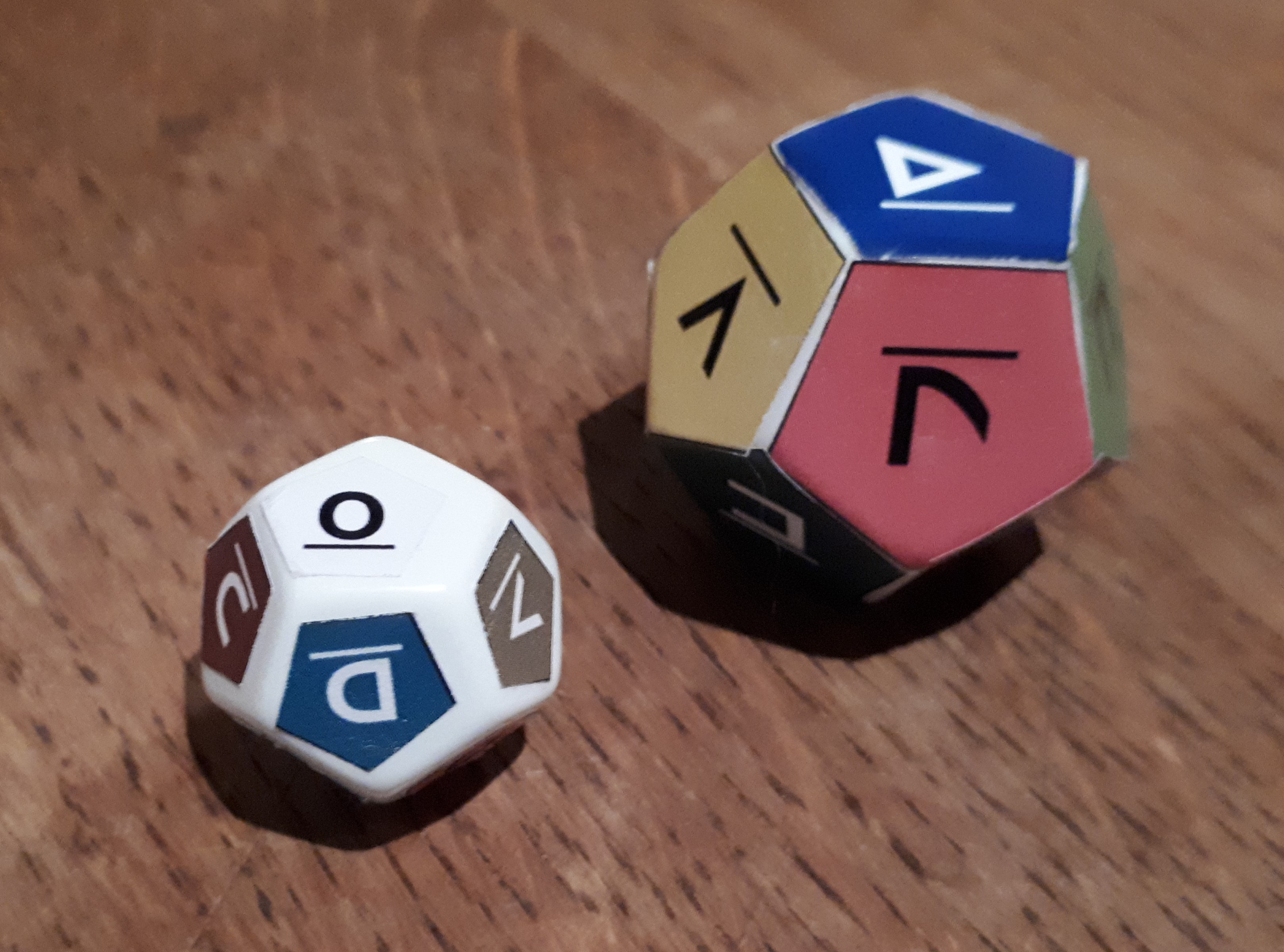
These rhombic dodecahedral dice are also marked ⑥-5; the result is a distribution centered on zero.
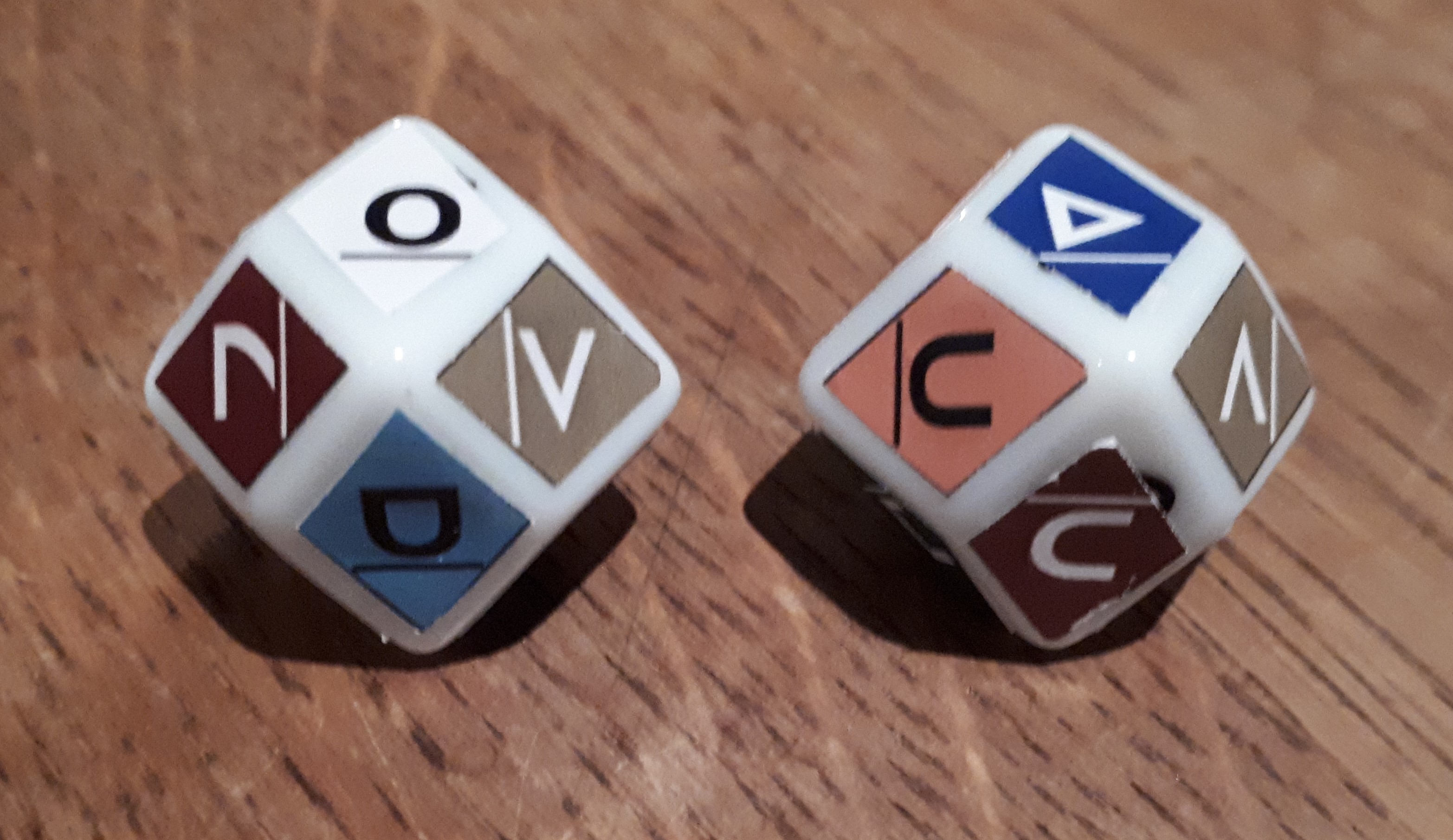
Let's count from 0 to 100 to show you how Janus numbers work:
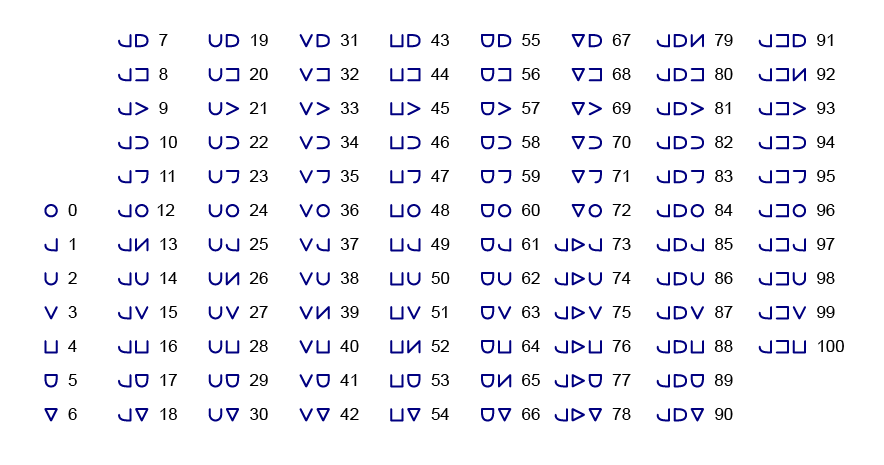
The first surprise is at number 7, which is written as 12-5, or , because 7 is closer to 12 than it is to 0. Rather than make a first approximation of the value of 7 by putting a 0 in the twelves place and then adding 7 units, we put a 1 in the twelves place and then adjust downwards by only 5 units.
After 18, numbers start being closer to two dozen than to one dozen, so there's a 2 in the dozens place, and likewise for all the numbers up to 29: they're closer to 24 than to any other multiple of twelve, so they have a 2 in the dozens place.
The next surprise is at number 73, which is closer to 144 than to 0, so we write it as 144-72+1 .
The Janus system uses both +6 and -6 , but not freely. Which one to use depends on the sign of the following digit: the two signs should be opposite. In other words, if the next digit is positive, use -6 ; if it's negative, use +6 . In each dozen, the first half follows +6, and the second half follows -6.
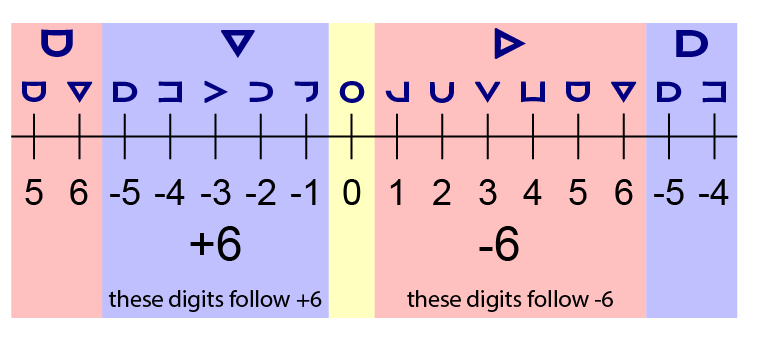
When it's the last digit, use +6 for positive numbers and -6 for negative numbers. When the following digit is a zero, keep looking to the right.
For example, the number 19 is written as 24 - 5, with a negative five. But we don't write 18 as 24 - 6 with a negative six: that would leave a negative six in final position. Instead, we write 18 as 12 + 6 with a positive six. Another example: the number 72 is written as 6×12 + 0, with a positive six: we ignore the zero and consider the six final. But 73 is written as 144 + -6×12 + 1: the six is negative because it's followed by a positive digit.
Here's a little toy to help you explore this new number system. Enter any integer and press the Count button. We'll show you the next six numbers in both Janus and decimal form.
Both the Janus numbers and the decimal values are the output of Javascript functions from a small library we created for handling Janus numbers. You can download this library for your own use here:
Magnitudes
Real numbers written in magnitude notation work the same in Janus notation as in decimal notation. We don't need the reciprocal sign, since a negative exponent is simply written with a negative (first) digit.
One advantage of Janus notation is that all the numbers near a given magnitude are written with the same magnitude. For example, in decimal scientific notation, the number 900 is written as 9x10², even though it's much closer to 10³. In Janus notation, that doesn't happen: the break where the magnitude changes is always at the midpoint of the higher magnitude.
Cuisenaire Rods & Slices
We 3D-printed a set of Janus Cuisenaire rods:
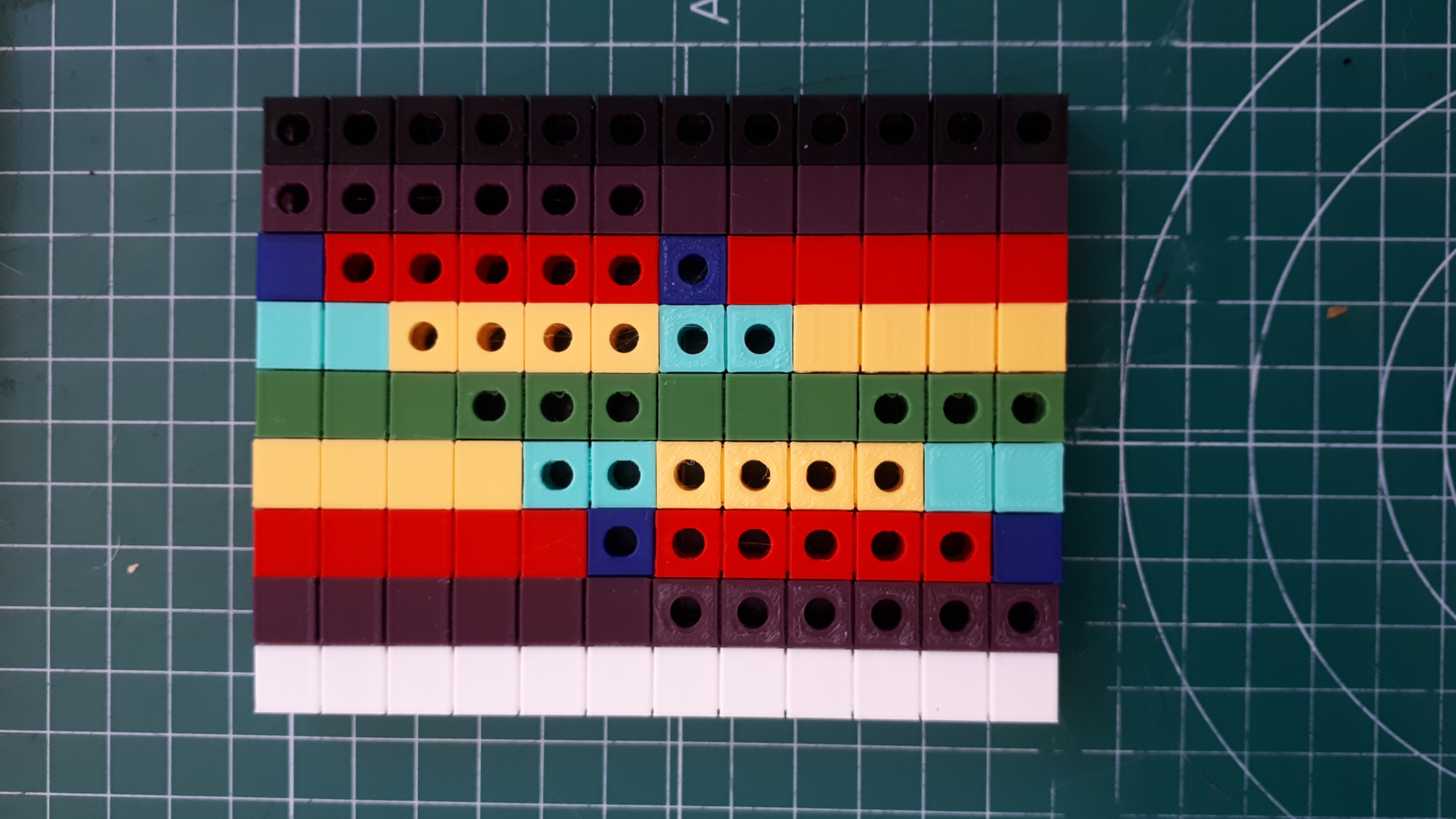
The rods with holes represent negative numbers.
We also printed a set of Janus Cuisenaire slices of a circle.
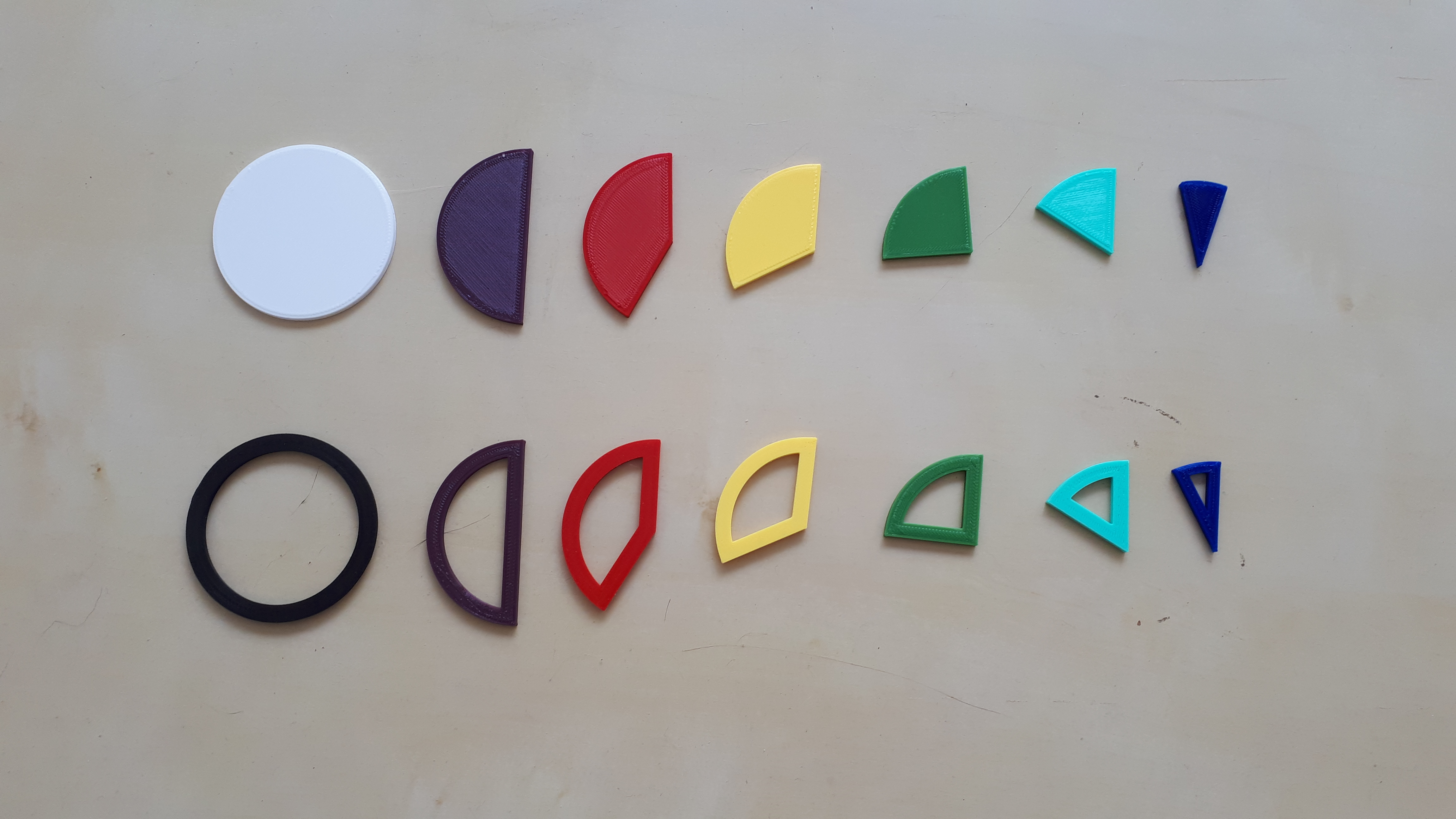
They show, better than the rods, that 5 + 4 = -3.
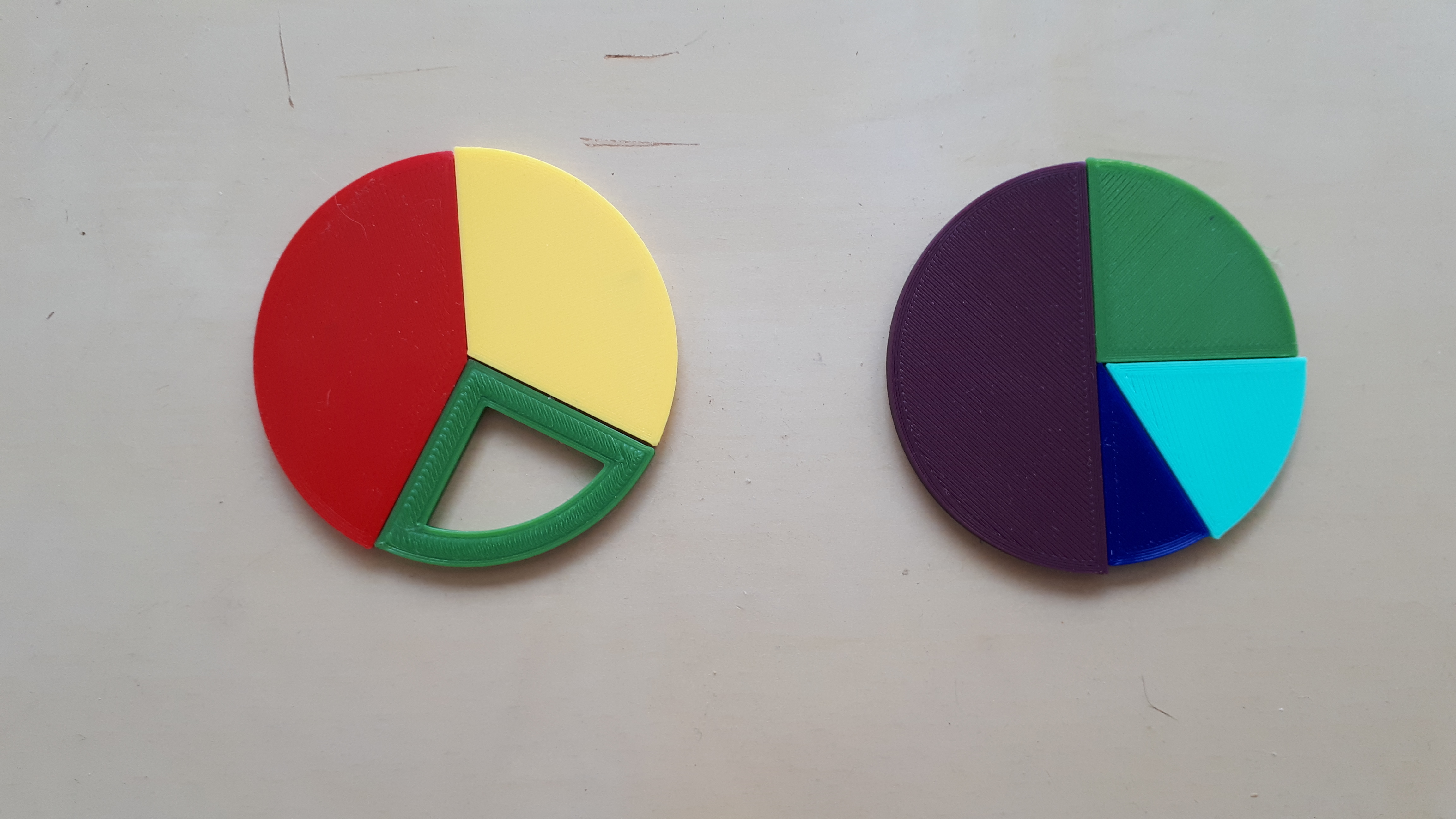
And here is a presentation of a Janus abacus.
Addition Table
Here is the addition table for Janus numbers:
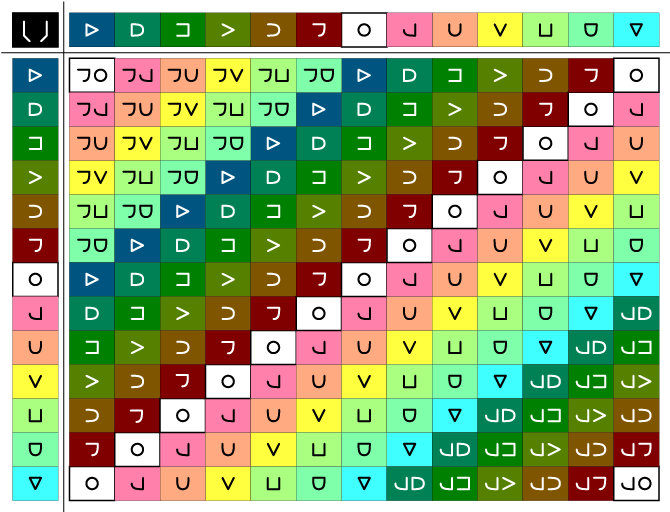
Just like the decimal addition table, the results form diagonal stripes across the table. But this similarity masks a significant advantage of Janus notation: because of the mix of positive and negative digits, there's much less "carrying" between columns when adding lots of numbers, and no "borrowing". Here is a sample sum in decimal and Janus notation:
| 11 | 1① | |
| 13 | 11 | |
| 17 | 15 | |
| 19 | 2⑤ | |
| 60 | 50 | |
In this example of the four teen primes, you have to carry a 2 in the decimal sum, but nothing at all in the Janus sum: the negative digits cancel out the positive ones.
The more numbers involved, the easier the Janus sum is in comparison to the decimal sum.
In decimal subtraction, we often have to "borrow" from the next higher column. For example, to subtract 17 from 42, you have to borrow 10 from the 40, effectively expressing 42 as "thirty-twelve" before you can subtract the 7 from the 12. But in Janus, you can subtract the 7 from 2, with no borrowing! You may have to carry a positive or negative one to the next column, but you don't need to borrow.
Multiplication Table
Here is the multiplication table for Janus numbers:
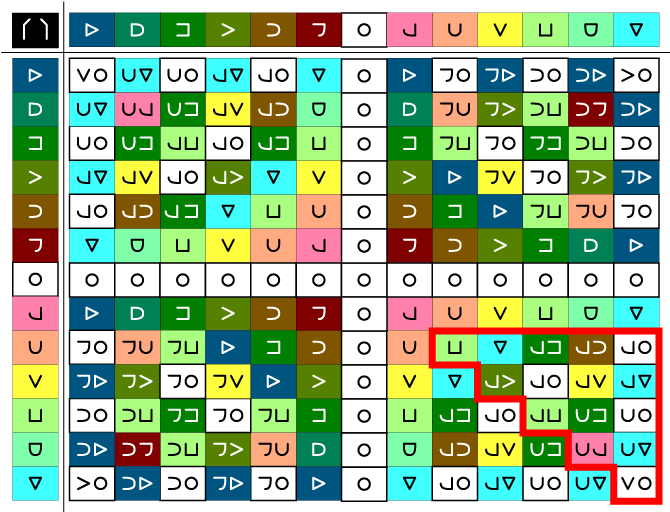
It looks daunting, but then patterns begin to emerge. Some are the consequence of choosing twelve as a base: since it divides all the digits except 5, most of the multiples just repeat the same final digits in the same sequence. In addition, you don't need to memorize very many numbers: only the 15 products in the red outline at lower right (all but one of them is a multiple of a factor of twelve). All the others are either multiples of 0 or 1 or the complements of other products. For example, if you learn that 4×5 = 2④, then you also know that 5×4 = 2④, that ④×5 = ②4, that 4×⑤ = ②4, and that ④×⑤ = 2④. Compare that to the 36 products you had to learn for the decimal multiplication table!
Divisibility Tests
It's easy to see whether a Janus integer is divisible by 2, 3, 4, 6 or 12 just by looking at the final digit. But there are also quick divisibility tests for the other small integers. To see whether a number is divisible by 8 or 9, look at the last two digits: if they spell a multiple of 8 or 9, it is. For example, the number (13851) is divisible by 9, as you can see because its last two digits spell (27), which is 3×9. The same trick works for 16, too.
For the small primes 5 7 11 13, there are some tricks. To see whether a number is divisible by 11, add the digits up. If the result is 0, it is. The test for 13 works almost the same, but instead of adding them all, you subtract every second digit. For example, to test the number (728), you calculate 5 - 1 + ④, which is 0.
The tricks for 5 and 7 are similar, but you double each result as you add. For example, to test the number (595), you start with the first digit, 4. Double it, and add the next digit: 8 + 2 = 10. Double that, and add the next digit: 20 + ⑤ = 15. The result is 15, which is a multiple of 5, so the original number is, too.
In the case of 7, you do the same thing, but subtracting every second digit (as for 13). So to test (595) again, you start with the first digit, 4. Double it, and subtract the second digit: 8 - 2 = 6. Double that, and add the next digit: 12 + ⑤ = 7. Since 7 is a multiple of 7, the original number is, too. So 595 is divisible by both 5 and 7.
There's also a type of divisibility test that works for any factor, once you know its Magic Number. Let's use it to check for divisibility by 17 and 19. The Magic Number for 17 is -7, and the Magic Number for 19 is 8.
-
Take away the last digit, and call what remains the "stump".
Multiply the last digit - the one you took away - by the Magic Number.
Add the result to the stump (which has moved right).
If the result is divisible by your factor, so is the original.
Want to know more Magic Numbers? Ask me, and I'll tell you how to calculate them :)
Negative Recurrer
There is one more trick when representing numbers in Janus notation: it turns out that many fractions, when expanded in Janus notation, form a pattern where the same sequence repeats, but alternating between positive and negative values. In this case, we add a subtraction symbol before the recurrer (the second Break), to mean "repeat what follows, but change the sign each time".
To illustrate this, let's consider the decimal expansion for the fraction 1/7, a very interesting case. In decimal, it's written 0.142857... and we would write it in Musa numerals using two Breaks: -1°°142857. But when we convert it to balanced decimal notation, it becomes 0.143①④③... - the same three digits repeated in sequence, but with the sign changing every time. It works the same way in dozenal, too:
| One Seventh | Decimal | Dozenal |
|---|---|---|
| Positive | | |
| 0.142857… | 0.186A35… | |
| Balanced | | |
| 0.143①④③… | 0.2③⑤②35… |
Rounding
Note that 0.143, rounded off to three decimal places, is a much better approximation to 1/7 than 0.142, six times better. Because each new digit of a balanced number is no more than half of its place value, fractional expansions are actually a series of closer and closer approximations - you never need to revise a previous digit as we do now. Let me illustrate:
The decimal number 0.24 is a two-digit approximation of an actual value between 0.235 and 0.245. If the next digit turns out to be a 9, the three-digit approximation is 0.239 - the 4 has been revised to a 3. But the Janus number would resolve to - the doesn't need to be revised.
Now let's look at the case where the actual value is 0.2351. The two-digit decimal approximation is still 0.24, while the three-digit is 0.235. If you want to go back from three to two digits in your approximation, you don't know whether to use 0.24 or 0.23, since 0.235 is halfway in between. Our rule of thumb says "round towards zero", but in this case, that would be wrong.
In the analogous Janus case (substituting 6 for 5 because Janus is dozenal), the two digit approximation of a value of would be , and the three-digit would be - no revising needed! The last digit of the latter is a , which according to rule #0 above should be a , since the number is positive. But this isn't really a final digit, since there are more digits after it - they're just not showing at this degree of approximation.
This example can be generalized to say that in cases like this of successive approximations, the normal rule is suspended and both forms are acceptable: the one with and the one with . There need not be a canonical form, just as we recognize that 1.000… and 0.999… represent the same number.
If you have a rational number expressed as a duodecimal in Janus such that all of the digits after a certain point are zeroes - for instance, 1/4 = 0.2500000000..., then the last non-zero digit is in fact a "final" digit, and rule #1 applies. Likewise, if you are expressing a repeating duodecimal like 1/3 = 0.3333333333... using a recurrer, then the last visible digit is a "final" digit, and rule #1 applies. But for irrational real numbers, or rationals when you're only showing the first part, rule #1 doesn't apply: you may see a at the end of the visible expansion.
Fractions
Numeric bases are sometimes compared on how well they represent small-denominator fractions, so here's a sample of Janus fractions:
| 1/4 | 1/3 | 1/2 | 2/3 | 3/4 |
|---|---|---|---|---|
| | | | | |
| 1/6 | 1/5 | 2/5 | 3/5 | 4/5 | 5/6 |
|---|---|---|---|---|---|
| | | | | | |
| 1/7 | 2/7 | 3/7 | 4/7 | 5/7 | 6/7 |
|---|---|---|---|---|---|
| | | | | | |
| 1/8 | 3/8 | 5/8 | 7/8 |
|---|---|---|---|
| | | | |
| 1/9 | 2/9 | 4/9 | 5/9 | 7/9 | 8/9 |
|---|---|---|---|---|---|
| | | | | | |
| 1/10 | 3/10 | 7/10 | 9/10 |
|---|---|---|---|
| | | | |
| 1/11 | 1/12 | 1/13 | 1/14 | 1/15 | 1/16 |
|---|---|---|---|---|---|
| | | | | | |
And here is an interesting discussion of continued fractions.
Portions
You'll remember that Musa notation uses the Break without any exponent to indicate a true percentage (one restricted to values between 0% and 100%). In Janus notation, percentages larger than 50% are written starting with negative digits, to be subtracted from 100%. They don't require a leading 1, as they would if spelled as a number. And we call them "portions", since they're not hundredths.
| | °0 | 0% |
|---|---|---|
| | °3 | 25% |
| | °6 | 50% |
| | °③ | 75% |
| | °⓪ | 100% |
Because of this, the complement of any percentage is simply the negative. If 25% of the world writes in the Roman alphabet, then -25% doesn't!
Numeric Keypad
The standard Musa keyboard includes a Janus numeric keypad as its first two rows. Here's an excerpt showing only those keys we need for Janus numbers.
| | | | | | | | |
|---|---|---|---|---|---|---|---|
| | | | | | | | |
| | ⇧ | ⌫ | | ||||
You can play with it in the toy below, which converts Janus numbers to decimal.
Janus number:
Decimal value:
| < Arithmetic | Physical Units > |
| © 2002-2024 The Musa Academy | musa@musa.bet | 18jan24 |